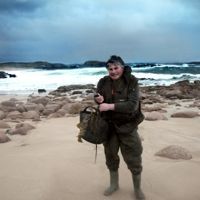Chefs today are asked for their opinions on many extraneous issues but rarely for their views on the economy. This may be an oversight given their position at the fulcrum of supply and demand.
Conversations in the kitchens of Ross Lewis of Chapter One, Dublin, Ireland, and Paul Flynn of The Tannery in Dungarvan, a two-hour drive down the coast south of Dublin, after we had enjoyed excellent meals in each restaurant promptly turned to the new challenges they are facing now that the Irish economy is finally improving.
The conversation in Dublin got under way with an astute comment about the Irish in general. We had been joined by the columnist Sam Smyth and his partner, television producer Angela Ryan. After being served a glass of Jean Thevenet's 2007 Mâcon by Chapter One's knowledgeable sommelier Ed Joliffe, Ryan commented, 'We Irish are in one of only two states: it is either party on or party over, and there is really nothing in between.'
The basement dining room of Chapter One (under the Writers Museum) certainly resonated with 'party on' the Saturday night we were there. The various small rooms were humming; tables were being turned; and, most noticeably, a significant number of the guests were in their late 20s or early 30s.
This popularity is hard-earned. Lewis and his team have been here for over 20 years and their restaurant runs like a well-oiled machine, albeit overlaid by distinctly Irish charm.
The most obvious source of this pleasure is an extremely well constructed menu. At dinner it consists of four courses with four or five choices at each course, a layout that allows the customer to follow their fancy in a most unconstrained manner.
Bowls of smoked potato and buttermilk soup and creamed tapioca with ewe's milk cheese and black truffles were two of the more comforting first courses. I thought I had made a mistake in not ordering the mallard with marinated Wicklow mushrooms as a second course until I ate the first slice of the smoked haddock with crab mayonnaise and pickled Atlantic seaweed. This fish is smoked and cured by Helen Mulloy in Howth, while the seaweed is harvested by Manus McGonagle (pictured above by Barry McCall) in Donegal. The result is a triumph that takes this often rather mundane fish to new heights.
The beauty of the main course that three of us chose, the black sole grilled over charcoal with salted grapes and shrimps from Castlebrownbere, lay not so much in its culinary technique but in its reminder of just how gentle and comforting this particular fish can be.
But it was the zinginess of the mandarin dessert that brought me face to face with Lewis. Looking in at the kitchen I had noticed the heavily tattooed arm of the pastry chef as he laid out desserts for the waiting staff to whisk away. As I stepped in to congratulate him, I saw Lewis, passed on my thanks and asked him specifically about why there were so many young customers in his restaurant.
He smiled before explaining. 'In a way they are the lucky ones. They were just graduating in 2008 when the recession hit and the banks had to stop lending, so these people could not take on any expensive loans. As a result they are in a position today to have a really good time.'
Lewis then explained that as commercial rents were currently relatively low, more new restaurants were opening, making recruitment more difficult. And as he expounded philosophically at the end of a busy night's service, his viewpoint seemed to chime with what has been a constant in this country's history: that a lot of talented young people are drawn to Dublin for their initial training but then, once technically far more proficient, they set off round the world to seek fortune and fame. He ended by hoping that as better times return, Dublin's restaurants will be able to lure more Irish chefs back.
Lewis was possibly so incisive because he chooses to keep out of the limelight. Although he is a veteran of a distinguished career, his very first cookbook will appear only later this month.
Paul Flynn of The Tannery in Dungarvan, on the other hand, is well known for many an appearance on Irish TV. Physically his restaurant, located 100 metres from the sea in a former tannery, is a strong expression of what a bustling town Dungarvan used to be. The waiting staff have to be particularly fit to carry every plate from the ground floor kitchen up two steep flights of stairs to a dining room bathed in light from the windows above. Strong natural light shows off strong natural ingredients: a crab 'crème brûlée', Flynn's signature dish, for instance, or monkish on the bone with a bouillabaisse sauce and a slice of local Cheddar.
But it was round the corner that Flynn's impact on the local economy was most obvious. A piece of waste land, where kids used to get up to no good, he explained, is now a large, pristine vegetable and herb garden that supplies the adjacent cooking school he has established. And the 14 cooking stations for the students today occupy what were two garages for properties built when the economy roared but subsequently fell vacant.
These two chefs seem to have their finger on the pulse of the economy as closely as on what is in season.
Chapter One 18 Parnell Square, Dublin 1; tel +353 1 873 2266
The Tannery Dungarvan, Co Waterford; +353 58 453420














